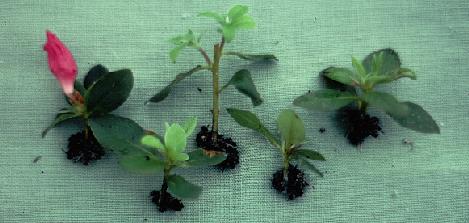|
Winter's ice and snow can often lead to broken branches on your azaleas. Don't despair, those branches can be rooted with relative ease during the winter months. Here is the procedure I use to start azaleas and rhododendrons from dormant cuttings. Even if the branch is quite desiccated, there is still a good chance of success at this time of year.
Procedure:
- For containers, I use cut-off gallon milk jugs. I make slits in the bottom for eventual drainage.
- Make short cuttings of a single whirl of leaves. Cuttings should be 2 inches long, or less. Sections of stems without leaves can also be used with some degree of success.
- Remove any flower buds from the cuttings since the plant's attempt to produce flowers will sap energy from new growth and root formation.
- Dip the end of the cutting in a rooting hormone such as Rootone or Dip 'N Grow.
- Insert the bottom inch of the cutting into a container filled with a porous potting medium ( I use ½ Peat, ¼ Sand, ¼ Perlite). The medium should be moist but not wet since excess moisture is the leading cause of failure due to fungal rot.
- If cuttings have evidence of insect or disease problems, they may be sprayed with an insecticide / fungicide mixture at this time and allowed to dry. (standard Rose Spray).
- Enclose containers in clear plastic bags to create a mini-greenhouse effect. Glad Gallon Food Storage bags fit the gallon milk jugs perfectly.
- Sometimes I will spray the foliage with a very dilute fertilizer mixture before enclosing the bags, but be careful to not make things too wet.
- Place under fluorescent lights with "long day" conditions (16 to 24 hours of light each day), or in a north window with good light but not too much strong sun.
- Cuttings should break dormancy and begin to grow in a month or so. At this time, they are usually forming new roots, too. Remove any cuttings that rot, or leaves that turn brown, but keep containers on the dry side since it will encourage root growth.
- Keep under lights during the winter months, and wait for warm humid weather to repot in late spring. The new foliage has been used to 100% humidity for many weeks, so open bags slowly at first and allow them to harden off before transplanting.
- Grow plants in pots during the summer, and allow them to harden off before frost in the fall. Cold frame protection is helpful during the first winter to protect from bark split, but plants rooted during the winter are often large enough by fall to make it on their own.
Note: Azaleas and rhododendrons can be raised from seed, too. The same basic approach is used, but no rooting hormone is needed. The seed is very small and should be sown directly on top of the medium. Germination will usually occur in just a few weeks, and plants will be ready for transplanting in a month or so.
Copyright © Donald W. Hyatt
Raising Rhododendrons and Azaleas from Seed
Back to Don Hyatt's Garden Page
Back to Don Hyatt's Main Web Page
|
